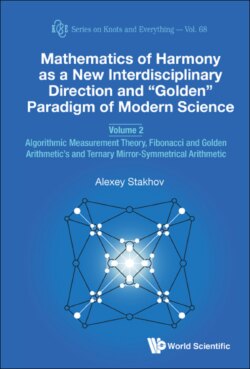Читать книгу Mathematics of Harmony as a New Interdisciplinary Direction and “Golden” Paradigm of Modern Science - Alexey Stakhov - Страница 24
1.8.4. Restrictions S
ОглавлениеIn the above definition of the (n, k, S)-algorithm, there is an important notion of the restriction S, which is superimposed on the measurement algorithm. It is clear that any restriction reduces the efficiency of the algorithm, but, on the other hand, each restriction, as will be shown in the following, leads to very unusual measurement algorithms that may be of theoretical and practical interest.
Let’s start from the simplest restriction that can be found from a comparative analysis of the classical measurement algorithms, in particular, the “binary” algorithm (Fig. 1.6) and the counting algorithm (Fig. 1.5).
Let’s compare the two 3-step (n, k, S)-algorithms presented in Figs. 1.5 and 1.6. Both algorithms are implemented in the same number of steps (n = 3) and use only one IE (k = 1).
What is the difference between these (3, 1, S)-algorithms? As the comparative analysis shows, the difference between them consists in the character of the movement of IE on the segment AB. Indeed, in the example in Fig. 1.6, an arbitrary movement of IE on the segment [0, 8] is allowed, that is, after a particular step, the IE can be enclosing at the next step both to the right or to the left relative to the point X. It is appropriate for the above restriction to use the notation S = 0. Then, we can consider the so-called (n, k, 0)-algorithms, that is, the measurement algorithms, in which the movement of IE on the segment AB obeys the restriction S = 0.
Let’s now consider the counting algorithm in Fig. 1.5. In this example, the movement of IE is subjected to the following strict restriction: in the process of operation of the algorithm, IE moves on the segment AB only in one direction: from point A to point B. In this case, IE participates in the measurement algorithm as long as it is “to the left’ from point X; as soon as IE “jumps” over point X, it stops its further participation in the measurement algorithm. Denote this restriction by S = 1. Then we also have the right to consider the so-called (n, k, 1)-algorithms, that is, the measurement algorithms, in which the movement of IE on the segment AB obeys the restriction S = 1.
Note that the restrictions S = 0 and S = 1 are not the only possible restrictions. It is important to emphasize that each restriction S leads to the discovery of some new class of the optimal measurement algorithms having theoretical or practical interest; therefore, the search for reasonable restrictions, imposed on the measurement algorithm, is an important task of the algorithmic measurement theory [16].
It is essential to emphasize once again that the classical measurement algorithms, discussed above, played an important role in the development of mathematics and computer science. In particular, the counting algorithm (Fig. 1.5) underlies the Euclidean definition of natural numbers (1.10) and the Eudoxus–Archimedes axiom;the “binary” algorithm (Fig. 1.6) underlies the “binary” system (1.12), without which it is impossible to imagine modern computer science, that is, these simplest measurement algorithms affect the foundations of mathematics and computer science.
